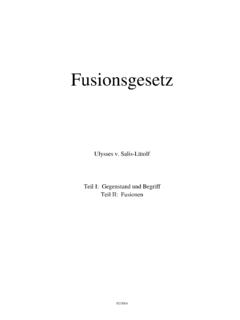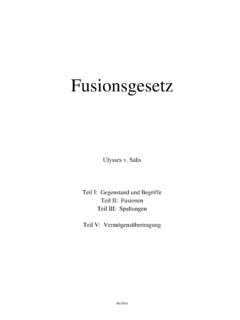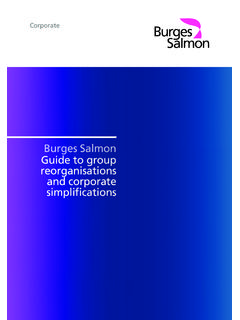Transcription of FusG E 4.2.05 - fusionsgesetz.ch - FusG - Swiss Merger Act
1 02/2005 Swiss Merger ACT On July 1st, 2004, the new Swiss Merger Act came into force. By means of a codification of recent practice, supplemented by quite detailed procedural provisions, this law makes available certain important new trans-actional tools for facilitating reorganisations. Its main focus is on provisions relating to reorganisations of share corporations and limited liability companies. The law also applies, however, to all other types of compa-nies, including general and limited partner-ships, as well as to associations and founda-tions; areas in which up to now there was no codified law.
2 Furthermore, and importantly, the revision of the relevant tax laws has re-moved certain hindrances to reorganisations and eliminated some legal uncertainties. I. OVERVIEW 1. Scope The Merger Law regulates in detail all types of reorganisations of entities under private law. The main focus is on provisions relating to reorganizations of corporations (Aktiengesellschaften, AG) and limited liability companies (Gesell-schaften mit beschr nkter Haftung, GmbH). Articles 3 to 77 mainly apply to these two (references to articles are to articles of the Merger Act applying for corporations and limited liability companies).
3 The law also applies to general partnerships (Kollektivgesell-schaften); limited partnerships (Kommanditge-sellschaften); cooperatives (Genossenschaften); cooperations with unlimited partners (Kommanditaktiengesellschaften); associations (Vereine); foundations (Stiftungen); welfare institutions (Vorsorgeeinrich-tungen) and, finally, institutions under public law (Institute des ffentlichen Rechts) (in civil law transactions). In general, except for the provisions on the transfer of assets and liabilities, the law does not apply to simple partnerships (articles 530 et seq.)
4 CO). Furthermore, the law does not exclude in any way the permissibility of indi-vidual transfers of assets. 02/2005 2 2. Transaction Structures Mergers (Fusionen) a. General A Merger combines two or more compa-nies in a manner such that at least one initial company (absorption) or all of the initial companies (amalga-mation) are dissolved. In principal all of the shareholders/members of the merging entities become shareholders/ members of the mer-ged entity.
5 (Articles 3 to 29) b. Specifics Efficient and easy procedure for group internal mergers Simplified procedure for small or me-dium sized enterprises (SME) Transfer of all assets and liabilities by operation of law (including contracts without consent of third party) Possible to grant an right to opt for shares or cash to shareholders of trans-ferring entity (article 8 section 1) Squeeze-out of shareholders of transfer-ring entity possible (article 8 section 2) There are only few cases where no Merger is permissible ( no merging of a corporation into a partnership)
6 (ar-ticle 4) Lengthy ordinary procedure Creditors may request security for their claims (article 25) by amalgamation=by absorptiontransferringabsorbing 02/2005 3 Demergers (spin-offs, splitting) (Spaltungen) a. General In a demerger, por-tions of the assets and liabilities are trans-ferred to a newly founded or already-existing company in a manner such that the shareholders obtain in addition to their shares in the initial company either a pro rata (symmetrical) or non-pro-rata (asymme-trical) percentage of shares in the absorbing company.
7 (Articles 29 to 52) b. Specifics Simplified procedure for small or me-dium sized enterprises (SME) Transfer of all assets and liabilities by operation of law (but unclear whether transfer of contracts requires consent of third party) Asymmetrical demerger (resulting in squeeze-out) possible (article 31 sec-tion 2) Only among corporations, limited liabil-ity companies and cooperatives (article 30) Lengthy ordinary procedure Inventory with a detailed list of all transferred assets and liabilities be-comes accessible to public (article 37 litera b)
8 Secondary liability for all of the liabili-ties of the transferring company (arti-cle 47) Creditors may request security for their claims (article 46) division=spin-offtransferring absorbing=symmetricalasymmetricalshareho lder Ashareholder Bshareholders A&Bshareholders A&BA : BA : BA : BA : BABtransferring absorbing 02/2005 4 Conversions (change of corporate form, transformation) (Umwandlungen) a. General By means of a conver-sion, a company changes its form of organization and adapts its shareholders' rights to the new form of organization, mean-while the composition of its shareholder con-stituency remains the same.
9 There is no transfer of assets or liabilities. (Articles 53 to 68) b. Specifics No additional rights for creditors Selected cases of full compatibility where conversions are possible (article 54) corpo-rationlimited liability companycooperative 02/2005 5 Transfers of Assets and Liabilities (Verm gens bertragungen) a. General A transfer of assets and liabilities entails the transfer by law of a list of specified, hand-chosen assets and lia-bilities to the trans-feror.
10 Such transfer does not affect the rights of the share-holders. (Articles 69 to 77) This tool is entirely new and offers a wide range of possible purposes, such as, for example, the transfer of hand-chosen groups of assets and liabilities to a third party or to a new subsidiary. It also serves as a backup transaction tool in instances in which none of the other transaction structures are feasible. b. Specifics May be used by any entity or any person registered in the Commercial Register Transfer of all assets and liabilities by operation of law (but unclear whether transfer of contracts requires consent of third party) No shareholder approval Normally transferring entity has to re-ceive a consideration (article 71 section 1, litera d) Purchase price and inventory with a detailed list of all transferred assets and liabilities becomes accessible to public (article 71 section 1 litera b and c) Joint and several liability (Soli-darhaftung)


